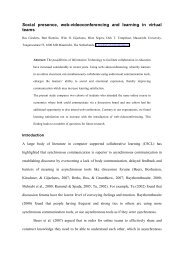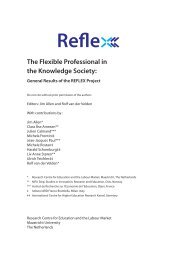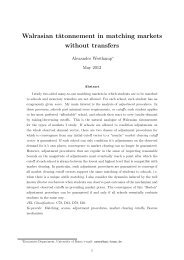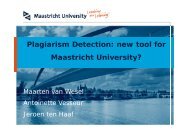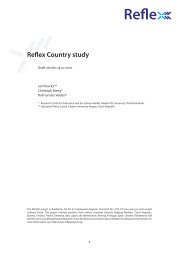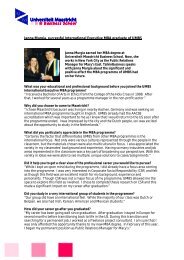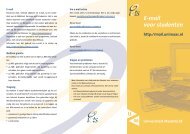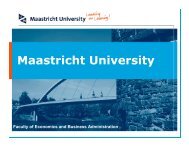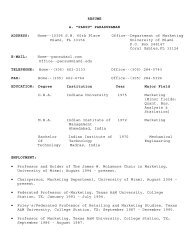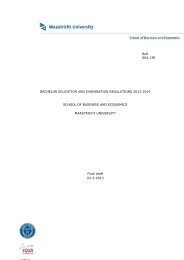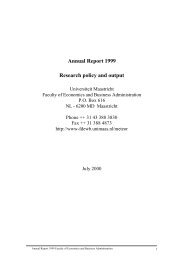proceedings of Student Mobility and ICT: Can E-LEARNING
proceedings of Student Mobility and ICT: Can E-LEARNING
proceedings of Student Mobility and ICT: Can E-LEARNING
Create successful ePaper yourself
Turn your PDF publications into a flip-book with our unique Google optimized e-Paper software.
Enhancing Teaching Through Technology<br />
challenges <strong>and</strong> possibilities<br />
David Durkee, Stephen Brant, University <strong>of</strong> East London, UK<br />
durkee@uel.ac.uk, brant@uel.ac.uk<br />
Abstract: The authors’ conducted a live learning lab at the UEL Learning <strong>and</strong> Teaching<br />
conference in London on June 26, 2008 with the same name. The following provides a<br />
write-up <strong>of</strong> the methods, technologies, lessons learned <strong>and</strong> recommendations, in a<br />
hopefully accessible piece. The goal is to produce something that is useful to academics<br />
in the classroom, as well as administrators who would like to incorporate more<br />
technology as a means to enhance their students learning <strong>and</strong> knowledge acquisition<br />
through distance learning applications. The lab proved successful both in the remote<br />
presentation as well as the visual analogy. The results appear useful for those wishing to<br />
deliver content remotely <strong>and</strong> especially as in this case, those who have a need to present<br />
from a remote location. The latter would be especially valuable for researchers in the<br />
field that would like to share results, either with fellow researchers or even to conduct<br />
lectures <strong>and</strong> presentations from the field.<br />
Background<br />
The application <strong>of</strong> technology in the classroom can significantly enhance learning <strong>and</strong> teaching<br />
outcomes. However, use in the classroom is circumscribed by the inherent benefits, limits, <strong>and</strong> even risks<br />
<strong>of</strong> each technology. Technology can thus be both enabler <strong>and</strong> limiter at the same time. Furthermore, while<br />
many educators underst<strong>and</strong> the aforementioned in theory, their practical experience proves lacking. Thus,<br />
discussions <strong>of</strong> technology <strong>and</strong> education tend to focus on possibilities <strong>and</strong> to some further extent expected<br />
benefits. However, real risks <strong>and</strong> limits exist as to the degree technology can enhance teaching.<br />
On the 26th <strong>of</strong> June 2008 for the UEL Learning <strong>and</strong> Teaching Conference, the authors conducted a<br />
live learning lab. The presentation aimed to enable participants to experientially explore the challenges <strong>and</strong><br />
possibilities <strong>of</strong> enhancing teaching through technology. Using a vRoom powered by Elluminate <strong>and</strong> Skype,<br />
the content on interpreting Jisc/TurnItIn results was delivered from Geneva. Therein, the audience enjoyed<br />
a visual analogy due to the media chosen for the presentation. As Pr<strong>of</strong>essor Andy Pausch said in his last<br />
lecture, it was a headfake. Operating at two levels the goal was to enable participants to better underst<strong>and</strong><br />
what needs to be done to incorporate the use <strong>of</strong> technology into teaching, while they were there to see a<br />
presentation about TurnItIn/Jisc.<br />
From the initial audience feedback, the presentation appears to have been a success. However, in<br />
journaling the results <strong>and</strong> sequence <strong>of</strong> events, the authors have also found places that can be improved, as<br />
well as ways to overcome some <strong>of</strong> the traditional limits. The insights are <strong>of</strong> particular relevance to those<br />
interested in knowledge acquisition in e-learning <strong>and</strong> distance education.<br />
The Live Learning Lab<br />
Instead <strong>of</strong> making a generic presentation on the use <strong>of</strong> a technology <strong>and</strong> the limits that one could<br />
encounter, the authors’ created an environment where the audience could participate <strong>and</strong> actually<br />
experience many <strong>of</strong> the limits. Officially the presentation was about the use <strong>of</strong> TurnItIn/Jisc (a system for<br />
checking the similarity <strong>of</strong> academic work). Of course one could have made such a presentation using a<br />
powerpoint, or on the screen by taking the audience through the schools virtual learning environment<br />
(VLE), <strong>and</strong> demonstrating how jisc works. In fact, such a presentation was originally suggested.<br />
The idea for the live learning lab emerged when it occurred that in fact one <strong>of</strong> the authors would<br />
have to be in Geneva during the conference <strong>and</strong> would not be able to attend in person. In discussing the<br />
possibilities for the presentation, it occurred that one <strong>of</strong> the possibilities would be to do a remote<br />
presentation. Through internet technologies for sending live audio <strong>and</strong> video Mr. Durkee could participate<br />
in person. The realities <strong>of</strong> the timing, <strong>and</strong> the lack <strong>of</strong> tested technologies at the University for making the<br />
presentation, added a dimension where the audience would experience the feed in real-time.<br />
Conference <strong>proceedings</strong> <strong>of</strong> <strong>Student</strong> <strong>Mobility</strong> <strong>and</strong> <strong>ICT</strong>: <strong>Can</strong> E-<strong>LEARNING</strong> overcome barriers <strong>of</strong> Life-Long learning?” 116




